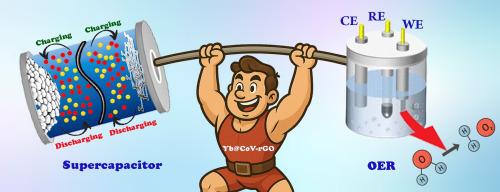生物质工程氧化石墨烯与掺镱焦钒酸钴耦合:超级电容器和OER活性的可持续电极材料
IF 5.1
3区 材料科学
Q2 MATERIALS SCIENCE, COATINGS & FILMS
引用次数: 0
摘要
下一代能量存储和转换技术的进步取决于高性能可持续电极材料的制造。目前的工作探索了一种环境友好的方法,用于从废芒果种子中产生的活性炭合成还原性氧化石墨烯(rGO)。通过溶剂热法将掺镱焦钒酸钴(Yb@Co₂V₂O₇:CoV)纳米颗粒锚定在还原氧化石墨烯上,生成Yb@CoV-rGO纳米复合材料。在2 mV/s的扫描速率下,这些材料被用作超级电容器的电极材料,并通过循环伏安技术观察到比电容(Csp)分别为128、413和769 F/g。以合成的活性炭为负极,Yb@CoV-rGO纳米复合材料为正极制备了不对称器件,在0.1 M H₂SO₄中,电流密度为1 mA/g时,比电容(Csp)为414.5 F/g。此外,还进行了出氧反应(OER)研究,观察到在电流密度为10 mA/cm2时,Yb@CoV-rGO和Yb@CoV存在下的过电位分别为320 mV和510 mV。Yb@CoV-rGO和Yb@CoV的Tafel斜率分别为196和394 mV/dec。在两项电化学研究中,Yb@CoV-rGO与其他两种原始材料相比,显示出增强的电化学性能。增强的电导率,优异的氧化还原行为,有效的OH -吸附和氧释放可能是Yb@CoV-rGO纳米复合材料活性增强的原因。所得结果证明Yb@CoV-rGO具有储能和转化的双重电化学活性。将废物转化为产生能源的增值产品旨在解决环境和能源部门的问题。本文章由计算机程序翻译,如有差异,请以英文原文为准。

Biomass-engineered rGO coupled with ytterbium doped cobalt pyrovanadate: A sustainable electrode material for supercapacitor and OER activity
The advancement of next-generation energy storage and conversion technologies depends on the fabrication of high-performance sustainable electrode materials. The current work explores the environmentally benign method for the synthesis of reduced graphene oxide (rGO) from activated carbon generated from waste mango seeds. Ytterbium-doped cobalt pyrovanadate (Yb@Co₂V₂O₇:CoV) nanoparticles were anchored to rGO through the solvothermal method to generate Yb@CoV-rGO nanocomposite. The materials were used as electrode material for supercapacitor applications and observed a specific capacitance (Csp) of 128, 413 and 769 F/g at a scan rate of 2 mV/s using the cyclic voltammetry technique. An asymmetric device was also fabricated using synthesized activated carbon as the negative electrode and Yb@CoV-rGO nanocomposite as the positive electrode, resulting in a specific capacitance (Csp) of 414.5 F/g at a current density of 1 mA/g in 0.1 M H₂SO₄. In addition, oxygen evolution reaction (OER) studies were conducted and observed overpotentials of 320 mV and 510 mV in the presence of Yb@CoV-rGO and Yb@CoV, respectively, at 10 mA/cm2 current density. The Tafel slope for Yb@CoV-rGO and Yb@CoV was found to be 196 and 394 mV/dec. Under both the electrochemical studies, Yb@CoV-rGO showed enhanced electrochemical performance compared to the other two pristine materials. The enhanced conductivity, superior redox behavior, effective OH− adsorption and oxygen release could be reasons for enhanced activity in the Yb@CoV-rGO nanocomposite. The obtained results justify Yb@CoV-rGO's dual electrochemical activity for energy storage and conversion. The conversion of waste into energy-generating value-added products aims to address environmental and energy sector issues.
求助全文
通过发布文献求助,成功后即可免费获取论文全文。
去求助
来源期刊

Diamond and Related Materials
工程技术-材料科学:综合
CiteScore
6.00
自引率
14.60%
发文量
702
审稿时长
2.1 months
期刊介绍:
DRM is a leading international journal that publishes new fundamental and applied research on all forms of diamond, the integration of diamond with other advanced materials and development of technologies exploiting diamond. The synthesis, characterization and processing of single crystal diamond, polycrystalline films, nanodiamond powders and heterostructures with other advanced materials are encouraged topics for technical and review articles. In addition to diamond, the journal publishes manuscripts on the synthesis, characterization and application of other related materials including diamond-like carbons, carbon nanotubes, graphene, and boron and carbon nitrides. Articles are sought on the chemical functionalization of diamond and related materials as well as their use in electrochemistry, energy storage and conversion, chemical and biological sensing, imaging, thermal management, photonic and quantum applications, electron emission and electronic devices.
The International Conference on Diamond and Carbon Materials has evolved into the largest and most well attended forum in the field of diamond, providing a forum to showcase the latest results in the science and technology of diamond and other carbon materials such as carbon nanotubes, graphene, and diamond-like carbon. Run annually in association with Diamond and Related Materials the conference provides junior and established researchers the opportunity to exchange the latest results ranging from fundamental physical and chemical concepts to applied research focusing on the next generation carbon-based devices.
 求助内容:
求助内容: 应助结果提醒方式:
应助结果提醒方式:


